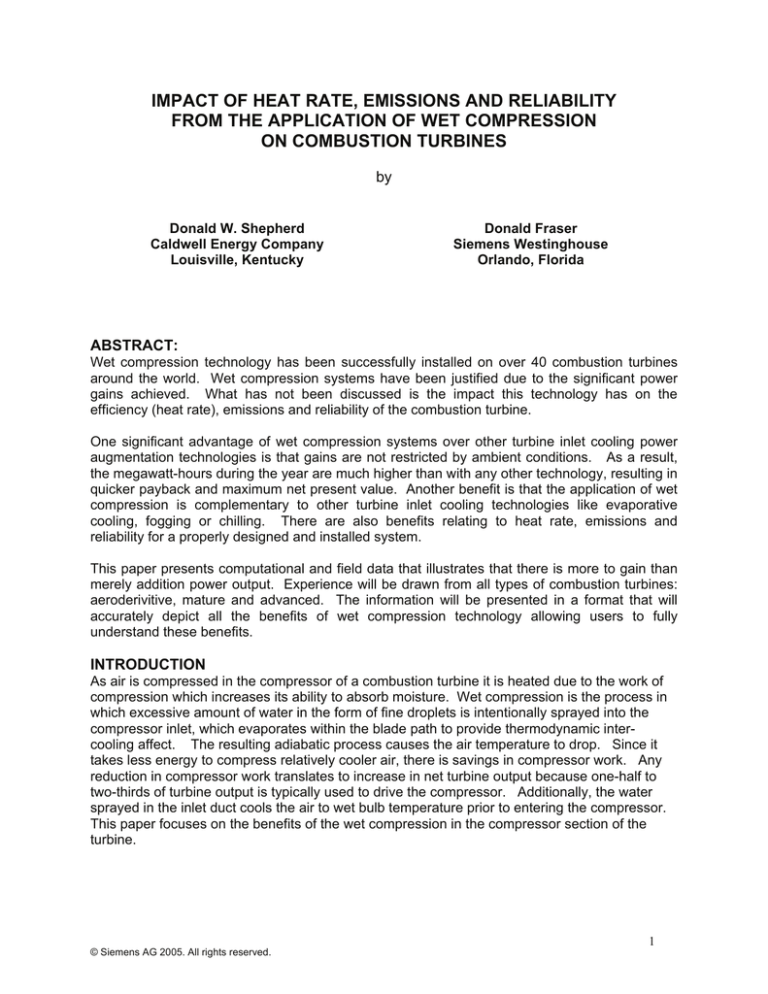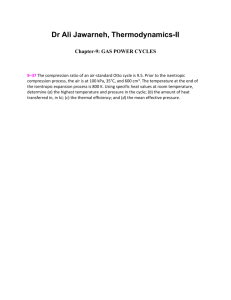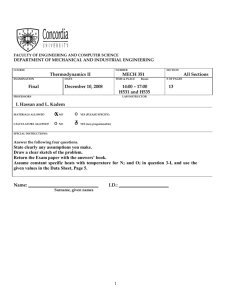
IMPACT OF HEAT RATE, EMISSIONS AND RELIABILITY
FROM THE APPLICATION OF WET COMPRESSION
ON COMBUSTION TURBINES
by
Donald W. Shepherd
Caldwell Energy Company
Louisville, Kentucky
Donald Fraser
Siemens Westinghouse
Orlando, Florida
ABSTRACT:
Wet compression technology has been successfully installed on over 40 combustion turbines
around the world. Wet compression systems have been justified due to the significant power
gains achieved. What has not been discussed is the impact this technology has on the
efficiency (heat rate), emissions and reliability of the combustion turbine.
One significant advantage of wet compression systems over other turbine inlet cooling power
augmentation technologies is that gains are not restricted by ambient conditions. As a result,
the megawatt-hours during the year are much higher than with any other technology, resulting in
quicker payback and maximum net present value. Another benefit is that the application of wet
compression is complementary to other turbine inlet cooling technologies like evaporative
cooling, fogging or chilling. There are also benefits relating to heat rate, emissions and
reliability for a properly designed and installed system.
This paper presents computational and field data that illustrates that there is more to gain than
merely addition power output. Experience will be drawn from all types of combustion turbines:
aeroderivitive, mature and advanced. The information will be presented in a format that will
accurately depict all the benefits of wet compression technology allowing users to fully
understand these benefits.
INTRODUCTION
As air is compressed in the compressor of a combustion turbine it is heated due to the work of
compression which increases its ability to absorb moisture. Wet compression is the process in
which excessive amount of water in the form of fine droplets is intentionally sprayed into the
compressor inlet, which evaporates within the blade path to provide thermodynamic intercooling affect. The resulting adiabatic process causes the air temperature to drop. Since it
takes less energy to compress relatively cooler air, there is savings in compressor work. Any
reduction in compressor work translates to increase in net turbine output because one-half to
two-thirds of turbine output is typically used to drive the compressor. Additionally, the water
sprayed in the inlet duct cools the air to wet bulb temperature prior to entering the compressor.
This paper focuses on the benefits of the wet compression in the compressor section of the
turbine.
1
© Siemens AG 2005. All rights reserved.
Early experimentation with the continuous injection of large volumes of water into a compressor
inlet, now referred to as Wet Compression (aka High Fogging, Overspray, super-saturation,
inter-cooling, Inlet Fog Boost and Continuous Water Washing) began in the early 1990’s. Being
pioneers in the use of on-line compressor water wash systems, the Dow Chemical Company
Employees began a program to determine how much water could be injected into the inlet of a
W501A combustion turbine, a 1968 vintage turbine rated at 40 MW. Working together with
engineers from Westinghouse Electric Corporation, an astounding increase in base load power
output of 25% was achieved. The Dow Chemical Company was awarded Patents for this work
and wet compression technology. Since that first system was designed and installed, there
have been many design enhancements to the injection system, spray atomization nozzles,
system controls, rotor grounding devices, and turbine hardware to reliably apply wet
compression systems to combustion turbines. System and spray technologies applied to the
wet compression process continue to be improved.
Since this early application of Wet Compression and the experience gained from it, Wet
Compression has been successfully applied to more than 40 units. These units include; GE
Frame 6B, LM2500PE, Alstom GT-24, Alstom GT-26, Siemens Power Generation W501D5,
W501D5A, W501FC, V84.2. While there are concerns with the application of wet compression,
if applied correctly it has been shown to reduce NOx, improve heat rate, and is a reliable source
of additional power regardless of ambient conditions.
Ambient Effects Combustion Turbines
Power gains from all inlet cooling technologies are limited by ambient conditions, thus limiting
the amount of reliable power gain. Evaporative cooling systems must have a temperature
difference between the dry-bulb and wet-bulb temperatures in order for power gains to be
achieved. Chiller based systems are typically designed to ASHRAE 1% or 2% conditions, thus
the system becomes limited when it is warmer or more humid than the design point. With Wet
Compression, gains are not limited due to increased ambient conditions. Graph 1 below depicts
typical percent power gains for combustion turbines, with evaporative cooling, with wet
compression, and with wet compression and evaporative cooling.
© Siemens AG 2005. All rights reserved.
2
Power Gains
30.0%
25.0%
20.0%
15.0%
Evaporative Cooling
2% Wet Compression
Evaporative cooling + 2% Wet Compression
10.0%
5.0%
0.0%
3.6
5.4
7.2
9
10.8
12.6
14.4
16.2
18
19.8
21.6
23.4
25.2
27
Delta T (F) Between Dry-Bulb & Wet-Bulb
Graph 1.
From Graph 1 it can be seen that wet compression gives a constant increase in power
regardless of the ambient conditions, thus a very reliable increase in capacity. Note that wet
compression is typically not utilized in temperatures below 45F. The reason for limiting the
system to operating above these temperatures is due to increased blade loading on the rear
compressor blades.
With a chiller system the power gain is limited by the difference between the ambient
temperature and the minimum inlet temperature set by the manufacturer, usually set at 42°F or
higher. Graph 2, depicts how the potential power gain decreases as ambient temperatures
decrease.
© Siemens AG 2005. All rights reserved.
3
Power Augmentation Potential
25%
20%
15%
Power Gain Potential
10%
5%
0%
50
60
70
80
90
100
Degrees (F)
As ambient temperatures increase the heat rate for combustion turbines increase (degrade).
For a typical combustion turbine for each degree in Fahrenheit increase in temperature the heat
rate degrades by approximately 0.1%. Even without the current increase in fuel cost,
improvements in heat rate are an important aspect of power plant operation, as fuel costs
increase they become even more important.
The data in Table 1 are actual results from testing of wet compression systems installed on the
various units. This data clearly shows that in additional to the power gain, the heat rate for the
CT was reduced for these units, by up to 2%.
Table 1: Performance Comparison of Various Combustion Turbines
Combustion Turbine
Siemens Siemens
GE
GE Frame
SWPC
Alstom GTW501FC
V84.2
LM2500PE
6B
W501D5A
24
Overspray, %
1.3
1.0
2
1
2
1.2
Compressor Discharge
90
50
Data not
Temperature Reduction,
available
50
100
48
°F
Fuel Flow Increase, %
N.D.
N.D.
4
8.2
13.2
5.5
Change in Base Load
Firing Temperature, ºF
CT Power Increase, MW
Steam Turbine Power
Increase, MW
CT Heat Rate
Improvement, %
NOx Info
No
Change
17
Simple
Cycle
N.D.
10%
© Siemens AG 2005. All rights reserved.
No
Change No Change No Change No Change
5.2
1.6
3.3
15
Simple
-.5
0.3 (est.)
2 (est.)
Cycle
2
0
1
2
N.D.
-14%
DLN
DLN
No Change
11.5
1.8(est.)
2
No Change
4
The combustion turbine models listed in Table 1, have in excess of 30,000 hours of operating
experience. The V84.2 removed water from the water injection into the combustors for power
augmentation; it was changed from a 1.5 to .5 ratio.
GT-24 Blades after 7000 hours
Arrays install in 6B
Air Filter Cartriges
Evaporative Cooler
Wet Compression Nozzles
Trash
Screen
Compressor
Location of Wet Compression Arrays on LM2500
© Siemens AG 2005. All rights reserved.
5
Effects on Emissions
With the application of wet compression it has been shown that NOx emission are reduced on a
per kW bases for conventional combustors. The amount of reduction is approximately half of
what is seen for same amount of water injection in the combustor for NOx control. However this
reduction in NOx comes without the heat rate increase associated with water injection. For the
LM2500 the amount of ammonia being used in the SCR was reduced by 14% after the
application of the wet compression system. For steam and water injected combustion systems,
there is a decrease in the amount of mass required for NOx control.
Conclusions
Wet compression technology is a turbine inlet cooling and compressor intercooling system that has
been successfully demonstrated on aeroderivitive, mature and advanced combustion turbines.
This technology has shown that with proper application it is the most reliable means of power
augmentation that reduces NOx emissions, and improves heat rate and is not ambient temperature
dependent like other turbine inlet cooling technologies.
The application of wet compression
systems should address the risks associated with spraying water into a CT compressor inlet. The
primary components of such risk included: (i) water distribution, (ii) degradation of compressor inlet
duct materials and fouling of the compressor, (iii) compressor casing distortion, (iv) Combustion
dynamic pressure, and (v) control system integration.
REFERENCES:
1. M. R. Sexton, H. B. Urbach and D. T. Knauss, “Evaporative Compressor Cooling for NOx
Suppression and Enhanced Engine Performance for Naval Gas Turbine Propulsion Plants”,
Presented at the International Gas Turbine & Aeroengine Congress & Exhibition,
Stockholm, Sweden, June 2-5, 1998.
2. B. Rising, S. Cloyd, et. al., “Wet Compression for Gas Turbines: Power Augmentation and
Efficiency Upgrade”, Presented at the Power-Gen International, Orlando, FL, November
1999.
3. S. Jolly, J. Nitzken and D. Shepherd, “Evaluation of Combustion Turbine Inlet Air Cooling
Systems”, Presented at the Power-Gen Asia, New Delhi, India, September 29-October 1,
1998.
4. R. Schick, K. Knasiak, “Spray Characterization for Wet Compression Gas Cooling
Applications”, Presented at the Eighth International Conference on Liquid Atomization and
Spray Systems, Pasadena, CA, July 2000.
5. S. Jolly, “Wet Compression – A Powerful Means of Enhancing Combustion Turbine
Capacity”, Presented at Power-Gen International, Orlando, FL, December 10-12, 2002.
6. S. Jolly and S. Cloyd, “Performance Enhancement of GT 24 with Wet Compression”,
Presented at Power-Gen International, Dec. 9-11, 2003, Las Vegas, NV.
7. J. Kraft, “Evaporative Cooling and Wet Compression Technologies”, Energy-Tech, February
2004.
8. M. Mercer, “Wet Compression Technologies for Combustion Turbines”, Diesel and Gas
Turbine Worldwide, pp. 27-29, May 2004.
9. W. R. Sexton and M. R. Sexton, “The Effects of Wet Compression on Gas Turbine Engine
Operating Performance”, Proceedings of the ASME Turbo Expo 2003, Atlanta, GA, June 1619, 2003.
10. S.Jolly and James Hinrichs, “Application of Wet Compression for Aeroderivative
Combustion Turbines” Presented at Power-Gen International, Orlando, FL December 6-8
2004.
© Siemens AG 2005. All rights reserved.
6







